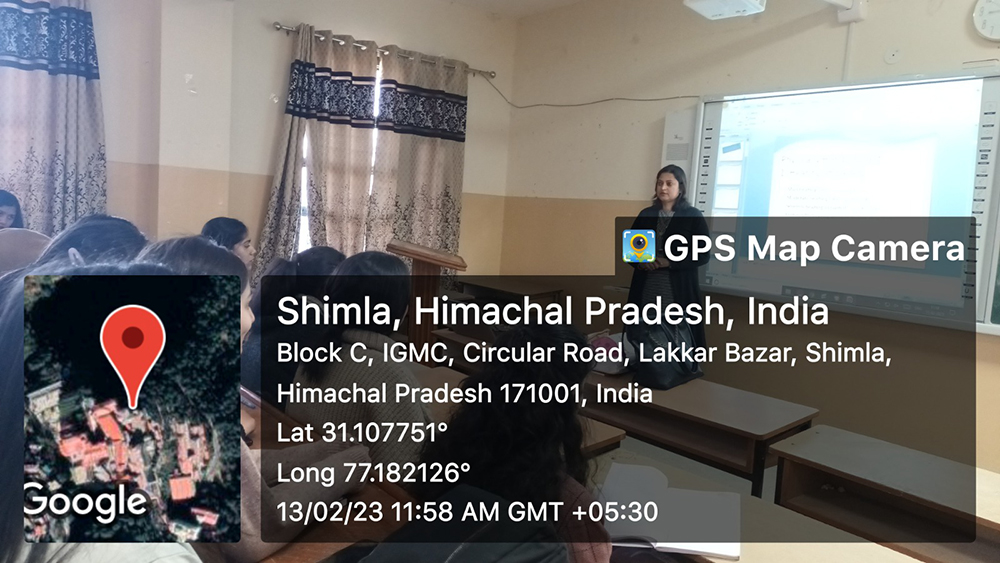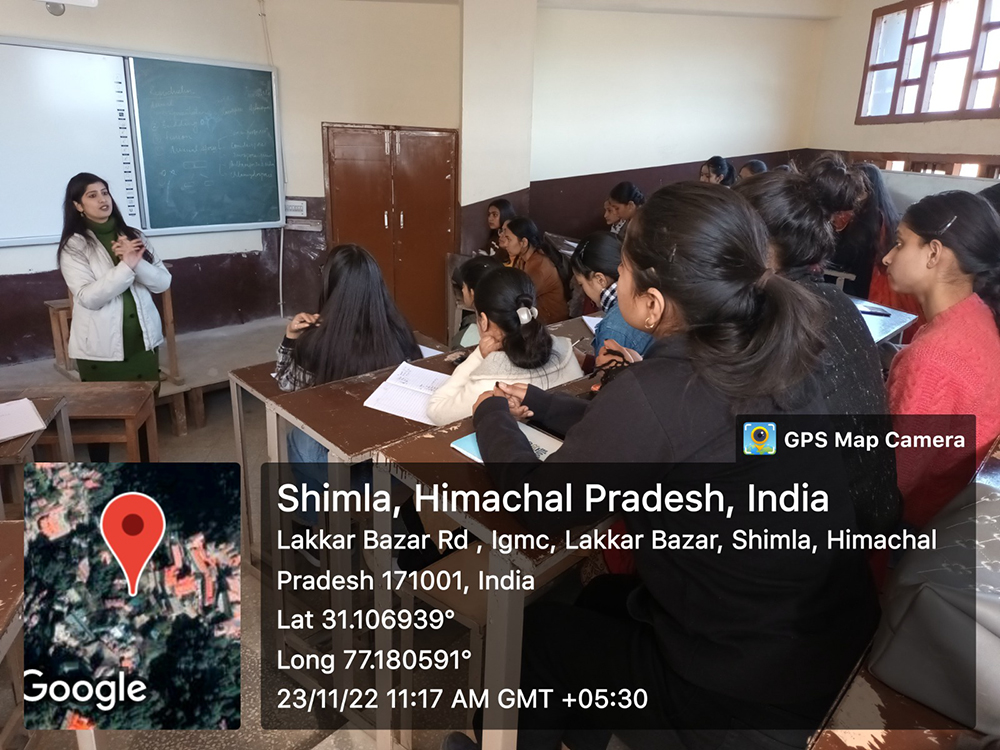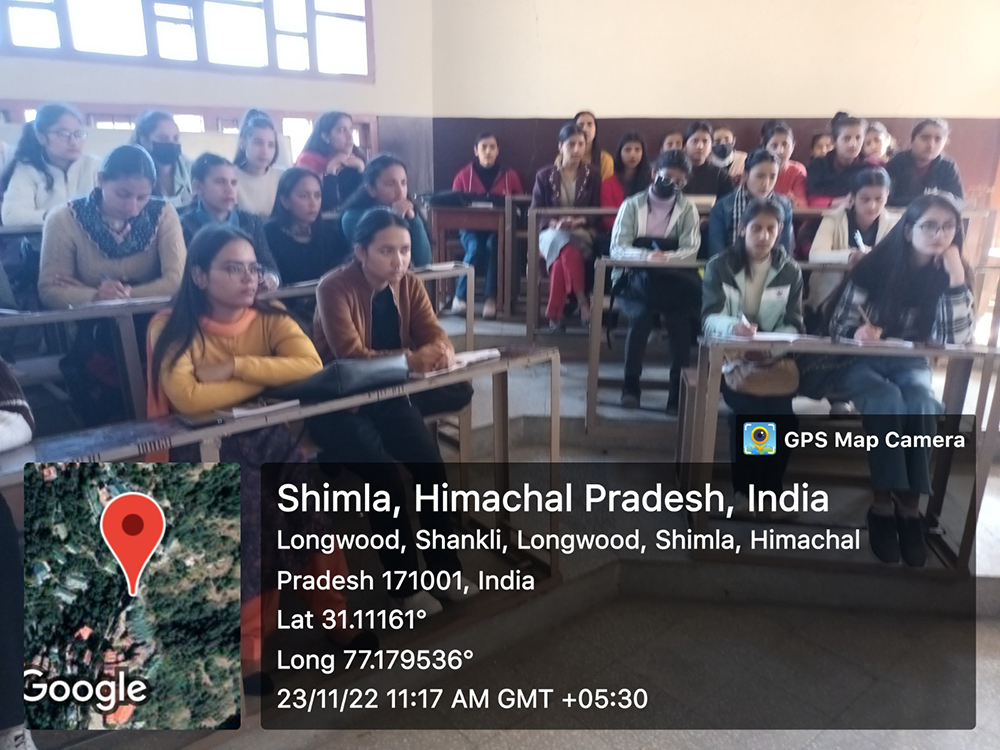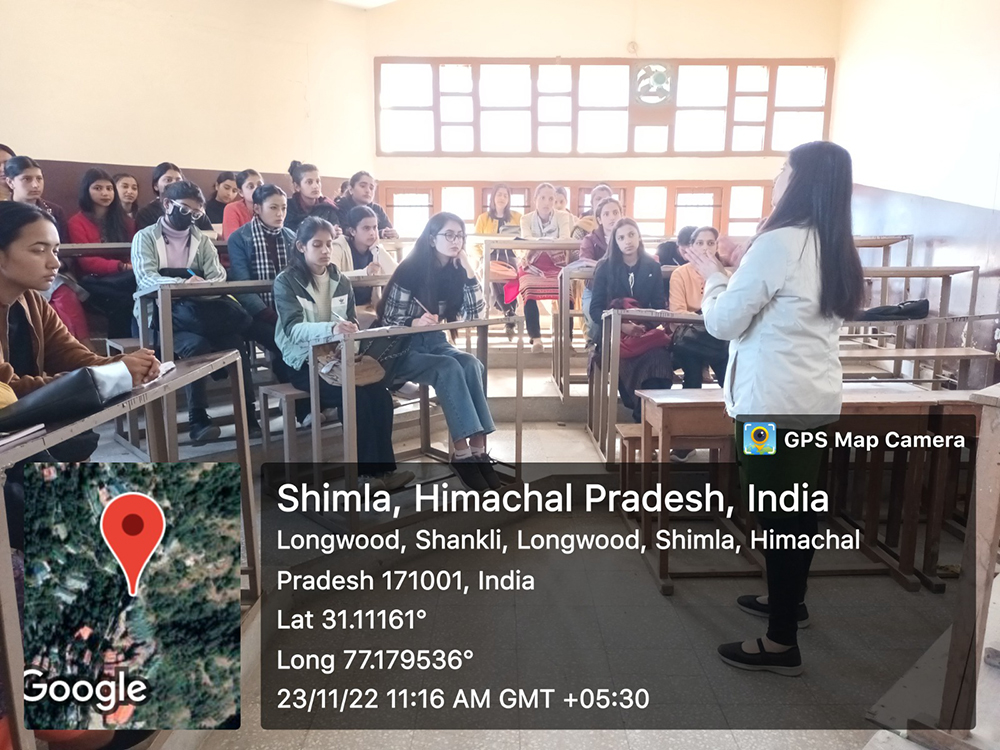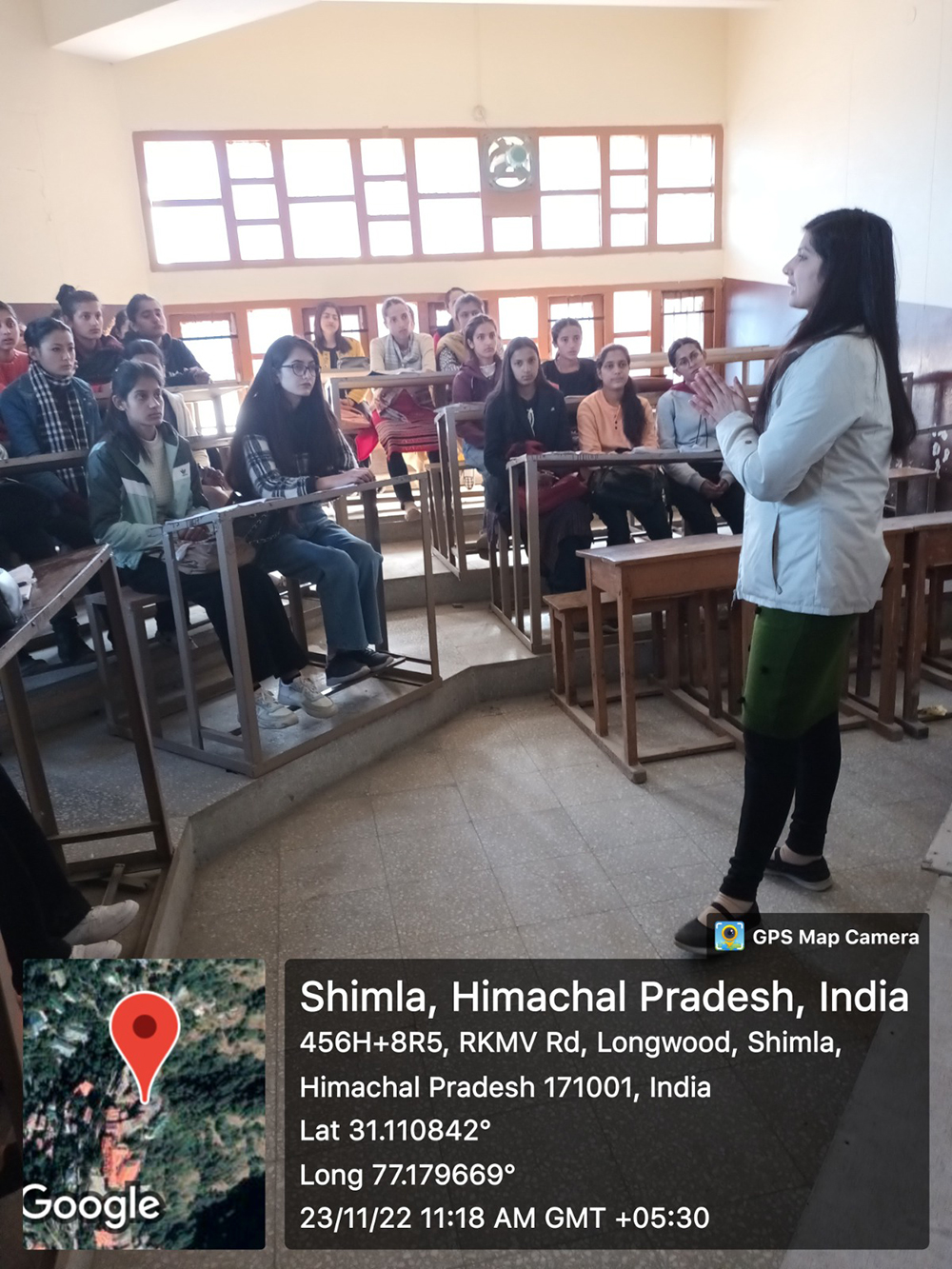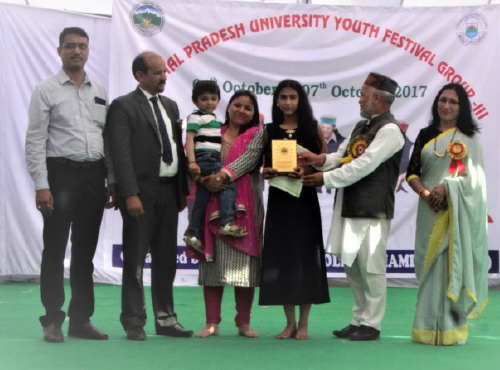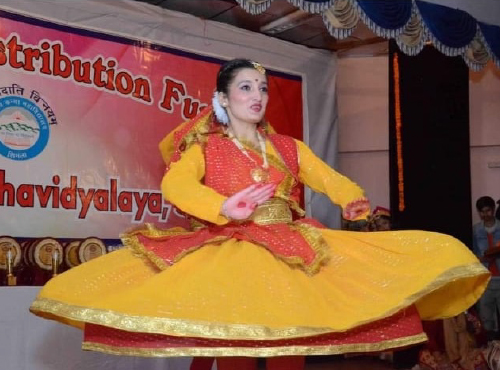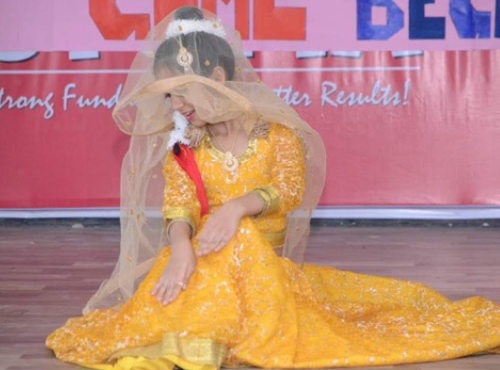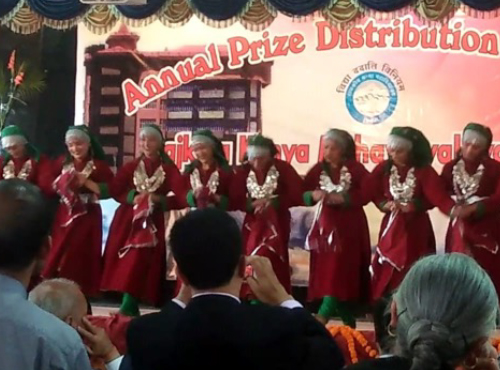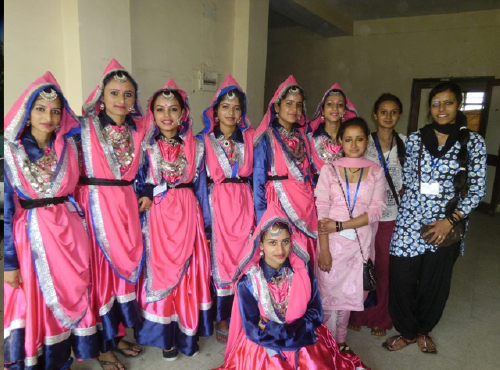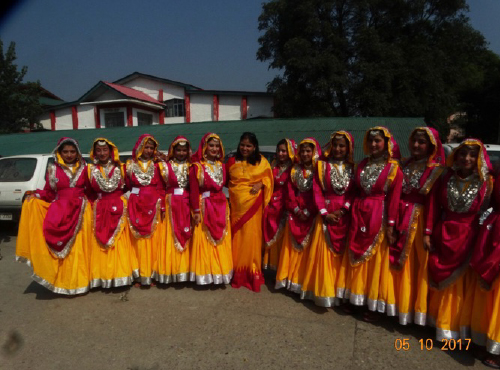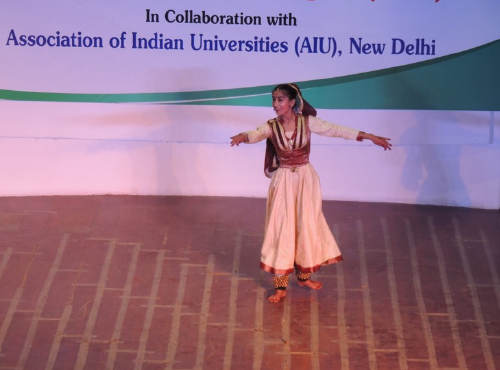Department of Dance was established at RKMV in 1977 as an evening department and Mrs. Ila Pandey has the privilege to be the founder of this department. In 1990 a regular day department was established here to enrich cultural heritage of India. The mission of the department is to promote our culture and traditional values system in a better way so that the coming generations may feel proud of our rich culture. With its several internal and external programmes the department of dance have achieved its mission successfully and have produces a good number of students who have achieved in different disciplines of life.
Indian classical Dance, Kathak is taught here as a subject, but simultaneously semi-classical and folk dances are also taught here. The day department is affiliated to Himachal Pradesh University where as the evening department is affiliated to Bhat Khandes Sangeet Vidyapith, Luknow. The day department imparts a bachelor degree whereas in the evening department students are enrolled for Prathama, Madhyama, Visharad I, Visharad II and Hobby classes. In evening department students above 8 years can enroll themselves, which makes it a special department of our institution. Students are awarded a Visharad Degree in Kathak dance after the completion of the course. Dance is a creative performing art so more and more emphasis is on enhancing the creative skills of the students which is also the motto of the department too.
List of the Courses:
| Year | Course Code | Course Type | Course Name | Course Outcome/Objective | |
|---|---|---|---|---|---|
|
BA First Year
|
DNCA101(TH)
|
Core Course
|
DSE 1A
|
General Theory of dance.
|
It helps the student to understand the history of Kathak dance and how it has evolved with time. Basic dance moves are taught in this class. |
|
BA First Year
|
DNCA102(PR)
|
Core Course
|
Practical
|
Practical
|
To perfect the basic dance moves.
|
|
BA First Year
|
DNCA103(TH)
|
Core Course
|
DSC 1B
|
Basic Dance Terms
|
In this class the emphasis is on
Natyashastra, Abhinav, laya, head gestures and Mudras.
|
|
BA First Year
|
DNCA104(PR)
|
Core Course
|
Practical
|
Practical
|
Teen Tal and Chautal
|
|
BA Second Year
|
DNCA201
|
Core Course
|
DSC 1C
|
Knowledge of Classical dances
|
Emphasis is on the techanalities of Kathak dance, Rasa and their applications in dance. |
|
BA Second Year
|
DNCA202
|
Core Course
|
Practical
|
Practical
|
Teen Tal, Ek tal, Gat nikas and Gat
Bhav
|
|
BA Second Year
|
DNCA203
|
Core Course
|
DSC 1D
|
Fundamental Technicalities of Dance
|
Kavit, Vandana, Gat, Gat Nikas,
Premalu, Nagma, nritta, Nritiya and Natya the forms of Kathak is taught
in this class
|
|
BA Second Year
|
DNCA204
|
Core Course
|
Practical
|
Practical
|
Stage performance of teen tal and
chautal, Bhav on thumari and bhajans
|
|
BA Second Year
|
DNCA205
|
Skill Enhancement Course
|
SEC -1
|
Value Based & Practical Oriented
Course for Kathak Dance
|
In this skill enhancing course
students are taught and encouraged to perfect their learnt skill by
creating groups and are asked to perform at different stages in and
outside college.
|
|
BA Second Year
|
DNCA206
|
Skill Enhancement Course
|
SEC -2
|
Value Based & Practical Oriented
Course for Kathak Dance
|
Emphasis is on Rasa, Nayak and
Niyka bhaedas in dance performances
|
|
BA Third Year
|
DNCA301
|
Skill Enhancement Course
|
SEC -3
|
Value Based & Practical Oriented
Course for Kathak Dance
|
To impart knowledge and techniques
of Indian ballet and folk dances. Basic techniques of Harmonium and
Tabla aare also taught in this
|
|
BA Third Year
|
DNCA302
|
Skill Enhancement Course
|
SEC -4
|
Value Based & Practical Oriented
Course for Kathak Dance
|
Choreography of classical and folk
dance with special emphasis on essential elements used in the classical
and folk performances.
|
|
BA Third Year
|
DNCA303
|
Discipline Specific Elective
|
DSE 1A
|
Theory Kathak Dance
|
In this course the students are
taught about the brief history of Indian dances with special emphasis on
the different styles of gharanas.
|
|
BA Third Year
|
DNCA304
|
Discipline Specific Elective
|
Practical/div>
|
Practical
|
Stage performances on Dhamar tal
and Teen tal
|
|
BA Third Year
|
DNCA305
|
Discipline Specific Elective
|
DSE 2A
|
Theory Kathak Dance
|
Gati, Bharamari, Premalu, Karan,
Anghar, Hela and Jatti movements, Chakaras and Bol are taught in this
class.
|
|
BA Third Year
|
DNCA306
|
Discipline Specific Elective
|
Practical
|
Practical Kathak Dance
|
Sawari and Teen tal with special
emphasis on Bhava on thumari, and bhajans
|
|
BA Third Year
|
DNCA307
|
Elective Generic (GE)
|
GE-1
|
Kathak Dance
|
Basic of Laya, Taal, Mudras,
Abhinava , Raas and Bhava.
|
|
BA Third Year
|
DNCA308
|
Elective Generic (GE)
|
GE- 2
|
Kathak Dance Practical
|
Basic dance steps such as tatrak,r,
hand movements, chakras, aamad, tukra and paran,gat nikas
|
Students Enrolled
| Class | Total |
|---|---|
| 1st Year | 26 |
| 2nd Year | 13 |
| 3rd Year | 9 |
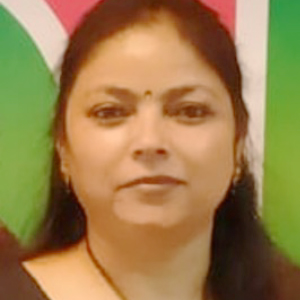
Usha Sharma
Assistant ProfessorFaculty Profile
| Faculty Name | Designation | Contact No. | E- mail ID |
|---|---|---|---|
|
Usha Sharma
|
Assistant Professor
|
9418451973
|
viksha2473@gmail.com
|
|
Lalit Kumar
|
Tabla Vadak
|
7018659788
|
lalitraghuvanshig@gmail.com
|
Bhat Khande Sandhya Sangeet Vidya Peeth RKMV College Shimla (Evening) Dances - Kathak
| Year Course Titles | Course Type | Syllabi. | Course Outcome/Objective |
|---|---|---|---|
|
First Year Prathama(Hobby)
|
Practical
|
1.Tatkar (Basic steps 2. At least
eight simple varieties of the Tatkar. 3. Basic hand movements combined
with Tatkar. 4. Rang Manch-ka-Tukda (Salami). 5. Two ‘Ta Thei Tat’
Amada. 6. Five examples of Tihais. 7. At least fifteen preliminary
Tukdas. 8. Practice of performing Chakra. 9. Practice of Padhant.
10.Three simple Nikas Gats with Chal
|
Basic dance moves are taught in
this class.
|
|
Second Year Prathama
|
Practical
|
A Trital 1. Athgun of the basic
Tatkar with speed. 2. One variety of Tatkar and at least ten variation
(Paltas). 3. Four variations of ‘Th Thei Tht’ Amada. 4. Four variations
of ‘Th thei Tat Thei’ Amads. 5. Ten Tukdas (sada) and Four Tukdas
(Chakradar). 6. Practice of performing Chakradar with more speed. 7.
Gatas of Nikhas Ghoongat and Gat Bhavas B. Jhaptal (1) Tatkar in
Barabar, Dugun and Chaugun Layas. (2) Five Tihais. (3) Two ‘Ta Thei Tat’
Amads. (4) Two ‘Ta Thei Tat Thei’ Amads/ (5) Rang Manch-Ke-Tukda
(Salami). (6) Four simple Tukdas and Two Chakkardar Tukadas. (7)
Practice of Padhant.
|
It helps the student to understand
the history of Kathak dance and how it has evolved with time. The
emphasis is on Natyashastra, Abhinav, laya, head gestures and Mudras to
perfect the basic dance moves.
|
|
Second Year Prathama - Theory
|
Theory
|
1. Classical dance forms of India
2. A smimple knowledge of the Kathak Dance. 3. Definition and knowledge
of them term Tatkar. 4. General definitions 5. Four neck moments as
given in Abhinaya Darpan. 6. Hand mudras 7. Angas, Pratyangas 8.
Qualities of Ghungaroos. 9. Essential qualities of a patra 10. Basic
knowledge of the 11. Brief life sketches of Kathak ancers 12. Notation
all the Talas and Bols learnt.
|
Emphasis is on the techniques of
Kathak dance, Rasa and their applications in dance with Teen Tal, Ek
tal, Gat nikas and Gat Bhav and Chautal
|
|
Third Year Madhyama -
|
Practical
|
A Trital 1. Advance Tatkar with
atleast ten Paltas. 2. A traditional Paran Prefixed Amad. 3. Thata
(Advance with Kasak and Masak). 4. Five variations of ‘Ta Thei Tat Thei’
Amads. 5. Four simple Parans and two Chakradar Tukdas. 6. Four simple
Parans and two Chakradar Parans 7. Performance of Chakradar with ease
and speed. 8. Six Gats of Bhava and Nikas. B. Jhaptal (1) Simple Thata.
(2) A Paran Perfixed Amad. (3) Four simple Tukdas. (4) Two Chakradar
Tukdas. (5) Two Parans. (6) One Chakradar Paran. C. Dhamar (1) Tatkar in
Bardar, Dugun and Chaugun Layas. (2) Rang March Ka Tukda. (3) Four
simple Tukdas. (4) Two simple Paran and one Chakradar Paran. (5) Two
Amads.
|
Kavit, Vandana, Gat, Gat Nikas,
Premalu, Nagma, nritta, Nritiya and Natya the forms of Kathak is taught
in this class.. Students are prepared for stage performance of teen tal
and chautal, Bhav on thumari and bhajans.
|
|
Third Year Madhyama-
|
Theory
|
1. Origin of Dance according to
natya Shastra of Bharata. (2) Nine head gestures, Eight eye glances 2.
Hand mudras 3. Definition 4. Basic terms. 5. Knowledge of the Talas – 6.
Like sketches
|
To impart knowledge and techniques
of Indian ballet and folk dances. Basic techniques of Harmonium and
Table are also taught in this.
|
|
Fourth Year Visharad Part I
|
Practical
|
A Trital 1. One advance Tatkar
variety with atleast ten variations. (2) Thata. 2. One Chatusrajati
Amad. 3. One Tisrajati Amad. 4. Two Paramelue Tukdas. 5. Two Natawari
Tukdas. 6. Four Parans (Two sada and two chakradar). 7. Tatkar in Tigun
and Chaugun Layas and increase in speed of Tatkar. 8. Two advance Gats
of Nikas and simple Holi and Govardhan Leela Gats. B. Dhamar (1) One
Amad. (2) Four Tukdas. (3) Two simple Parans. (4) Two Chakradar Parans.
(5) Four Tihais
|
In this students are taught and
encouraged to perfect their learnt skill. Choreography of classical and
folk dance with special emphasis on essential elements used in the
classical and folk performances
|
|
Fourth Year Visharad Part I
|
Practical
|
A Trital 1. One advance Tatkar
variety with atleast ten variations. (2) Thata. 2. One Chatusrajati
Amad. 3. One Tisrajati Amad. 4. Two Paramelue Tukdas. 5. Two Natawari
Tukdas. 6. Four Parans (Two sada and two chakradar). 7. Tatkar in Tigun
and Chaugun Layas and increase in speed of Tatkar. 8. Two advance Gats
of Nikas and simple Holi and Govardhan Leela Gats. B. Dhamar (1) One
Amad. (2) Four Tukdas. (3) Two simple Parans. (4) Two Chakradar Parans.
(5) Four Tihais C. Chautal (1) Tatkar in Bardar, Dugun and Chaugun
Layas. (2) Rang March Ka Tukda. (3) Four simple Tukdas. (4) Two simple
Paran and one Chakradar Paran. (5) Two Amads. (6) Four Tihais. (7)
Padhant of all the Bols learnt.
|
In this students are taught and
encouraged to perfect their learnt skill. Choreography of classical and
folk dance with special emphasis on essential elements used in the
classical and folk performances
|
|
Fourth Year Visharad Part I
|
Theory
|
1. Mudras denoting the Dieties 2.
Mudras denoting castes as given in Abhinaya parts. 3. Explanation of
Abhinaya and its four parts. 4. Elementary knowledge of the Nine 5.
Combined hand mudras 6. Dance. 7. knowledge of the Talas 8. Like
sketches. 9. To write in notation all the Talas and Boles learnt.
|
Gati, Bharamari, Premalu, Karan,
Anghar, Hela and Jatti movements, Chakaras and Bol are taught in this
class.
|
|
Fifth Year Visharad Part II
|
Practical
|
A Trital 1. Ability to improvise
extempore varieties in Tatkar 2. Performance of Chakkars with speed and
accuracy. 3. Advanced Thata. 4. One Amad Chatusrajati. 5. One Amad
Tisrajati. 6. One Paran Misrajati. 7. Two Paramelu Tukdas. 8. Two
Natawari Tukdas 9. One Chakradar Paran. One Sada Paran, 10. Tihais in
complicated Layas. B. Chautal (1) One Amad. (2) Three Parans. (3) Four
Tukdas, Three Parans, Two Chakradar & Two Chakradar & Tihais in any one
of the following Talas. (4) Ashtamangal (11 Matras). (5) Sawari (15
Matras). (6) Shikhar (17 Matras).
|
Sawari and Teen tal with special
emphasis on Bhava on thumari, and bhajans
|
|
Fifth Year Visharad Part II
|
Theory
|
1. Origin of Dance 2. Ten Pranas of
Taal 3. Combined (Sanyukta) hand 4. Analytical study of the following
main dance forms 5. The eight Nayaikas and four Nayaks 6. terms – Mudra,
Sawailaya, Paun Laya, Paun Dooni, 7. Critical analysis of different
Gharanas of Kathak Dance. 8. Critical analysis of the Lucknow Gharana 9.
A detailed study of Laya and its application. 10. Talas – Lakshmi,
Brahma, Vishnu Rudra..
|
In this class students are taught
the advance level of Dance techniques to so make the performances
better.
|
Facilities in the Department
The Dance department has following instruments to train the students to the highest level of perfection
| Name of Instrument | Nos. |
|---|---|
|
Tanpura (Electronic)
|
1
|
|
Tabla
|
2
|
|
Tabla (Electronic)
|
1
|
|
Harmonium
|
2
|
|
LED(TV)
|
1
|
|
Ragini (Electronic)
|
1
|
Activities and Achievments:
- 1. Students of Dance department represent college at H.P. University Youth festival Group III every year in Folk dance and Classical Dance events.
- 2. Have won sever prizes at H.P. Youth festival Group III in Folk dance and Classical Dance events
- 3. Have represented HP University in Inter University competitions and have won prizes
- 4. Each year students give a folk dance performance at Raj Bhawan on the eve of State level Teachers Day celebration.
- 5. Students actively participate and give performances in all cultural events at college level
- 6. Every year students are selected for Master’s in Dance at Punjab University Chandigarh and Punjabi University Patalia

